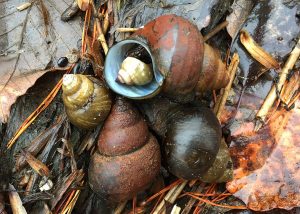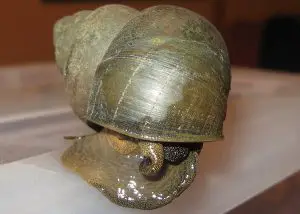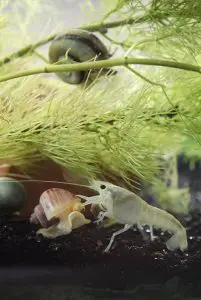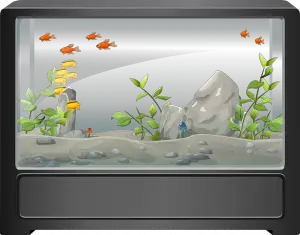Mystery snail is the most popular freshwater tank additions. These slow-moving, peaceful herbivores will allow you to sit back while doing some of the cleanings for you.
Most people will buy snails to clean the glass and algae rocks, like Nerite Snails. These Gastropods will benefit any community tank, no matter what level of experience it has.
In this article, we’ll discuss how to look after these fun little snails, including their appearance, breeding eggs, compatibility with other species.
Overview
Take a couple of minutes to watch the group of snails in the store and pick those who are moving or attached to a surface; never buy a snail that has a cracked shell.
The worst feeling you get home when you buy a snail is only to realize the beautiful shell you’ve picked out: a shell.
Those snails will live in the wild for about 1 year. They eat dead plants, and they purify the environment. This allows the return of any nutrients trapped in detritus to the ecosystem.
Their complex eyes that are placed on a cephalic eyestalk are a really interesting feature. There are no other sensory organs in the eyestalk, so if severed, it can regrow entirely after a few short weeks.
Another interesting note is that under the scientific name Cipangopaludina Chinensis and Japan under the scientific name Cipangopaludina japonica, there are other species of this snail from China. In some areas, they are regarded as an invasive species.
Both the Chinese and Japanese snails belong to another family; Viviparidae. Because of their size, they were originally brought into California for food trade. Common apple snails are used in commercial aquariums.
The focus of this article is on the common apple snail, Pomacea bridgesii.
Taxonomy
Here is the scientific classification of Mystery snail:
| Scientific classification | |
|---|---|
| Kingdom: | Animalia |
| Phylum: | Mollusca |
| Class: | Gastropoda |
| Clade: | Caenogastropoda |
| Family: | Viviparidae |
| Genus: | Cipangopaludina |
| Species: |
C. chinensis
|
| Binomial name | |
| Cipangopaludina chinensis | |
Description
Cipangopaludina genus species can be identified through their relatively large globose shells and concentrically marked opercula. The shell is conical and thin but solid, with a sharp apex and relatively higher spire and remote whorl of the body.
This species has a small and round umbilicus, and the spire is made at 65–80 ° angle. As an adult, Cipangopaludina Chinensis displays light coloration as juvenile and olive green, greenish-brown, brown or reddish-brown pigment. The coloration within is white to pale blue.
Cipangopaludina Chinensis shell grows allometrically (the height grows faster than the width) and does so at a lower rate compared to Cipangopaludina japonica so that the adult shell is less elongated than its congener shell.
The radula may also differ from Cipangopaludina japonica to Cipangopaludina Chinensis, but even within one species there is so much variation that it is not a good diagnostic characteristic.
Ecology
This species prefers soft, muddy or silty freshwater lakes, reservoirs, slow-moving freshwater rivers, streams, paddy fields and aquatic grass ponds, creeping at the bottom of water or on aquatic grasses.
In eastern North America, it prefers lentic water bodies with silt, sand, and mud substrates, though it can survive in slower stream regions as well. In stagnant waters close to septic tanks it can tolerate conditions.
Lifespan and size
In these types of snails, sexual reproduction takes place. This species has an ovoviviparous nature. Females live for up to 5 years and males live for up to 3 years, sometimes 4 years. Female fecundity usually exceeds 169 young in a lifetime and can reach up to 102 for any brood.
All females generally contain embryos from May to August and young women are born in shallow water in eastern North America from June through October, then females begin to migrate to deeper water for fall-winter. In her 4th and 5th years, females bear younger than in other years.
Typical Behaviour
These snails are one of the quietest creatures that you can have in your tank. Most of their time they spend grazing on the algae that builds up on the glass.
If an aggressive fish approaches them they will simply hunker down and hide in their shell. This does mean it’s important to keep them with peaceful fish. Making sure they ‘re not scared all the time means they’ll be more active and more effective at cleaning the tank.
On occasions, you may see the snails only go to the top of the tank to let go and free-fall to the bottom. Sometimes they just let go of a part of the foot and quickly slide down the glass.
Mystery Snail Appearance

Mystery snail come in a variety of colours. The black or brown, gold and ivory variants are among the most popular. These colors add a pleasant touch to your freshwater tank.
The shells come in solid, banded color, and the bright almost white head and color of the foot add a color pop. The possibilities of color and pattern in those snails are almost endless.
They’ll grow to a maximum of about 2 inches in diameter. This relatively small size enables them to be included in small as well as large tanks. When people think about snails they think about the spiral whorl beginning at the apex (the top) and expanding down to the opening or opening.
For these snails, this is no different but their apex is more on the side of their aperture. They have only about 4 whorls as adults, all of which are relatively minor.
Another part of their anatomy is an operculum that is the plate used for closing shell opening.
This is how a Bellamya Chinensis looks like

Once the snail is closed, their operculum looks like a big nail and is a good way to see if your snail is alive and healthy. When the organism dies, the operculum will fall off and will not closure properly if something is wrong with the snail.
Head is one of the most important pieces of their anatomy. They possess two large tentacles used to feel their surroundings and to find food. Their eyes are directly behind these long tentacles which detect light and movement.
Together these two help to find food and alert the predator snail. If a predator is spotted, the snail tucks inside the shell and closes the operculum until it is safe.
Below is their mouth, and the second pair of tentacles used to feed. They also have a siphon on the left side of the head, used to pass through their gills with water.
Ideal Habitat and Tank Conditions
This species is found in Paraguay, Brazil and Bolivia but it has now begun to spread to other parts of the world as invasive species. Especially in the northern states of North America, the Chinese species is becoming an issue.
They live native to ponds, swamps and rivers where they can feed on dead plants or decompose plants. They’ll feed on live plants but only when there’s no other source. They spend most of their time grazing on the surrounding bottom.
The only thing they need to watch out for is any fish or other creature that could break their tough shell. This can be any big fish or bird that might lurk in the water.
Here is an Image of A Snow White Crayfish (Procambarus sp.) Fighting a Mystery Snail (Pomacea bridgesii) for Food.

Tank conditions
Keep your tank full of vegetation to keep those snails right at home. Not only does this look nice but it also gives plenty of natural food. Java Fern, Java Moss, and Hornwort are common plants to include; they are all incredibly hardy.

These snails tend to swim off the water, particularly when food is low. Use a tight-fitting lid to make sure all of your snails remain in your aquarium.
By nature, they are hardy but try to avoid rapid changes in the conditions of the water. They ‘re well suited for highly oxygenated, moderately moving waters.
That’s another reason they ‘re often added to tanks in the tropical community.
The high levels of oxygen are achieved through vegetation which is a key feature in many tropical communities.
As for the water conditions, the numbers are simple:
- pH level range: 7.6-8.4
- Temperature range: 68°F-84°F
- Water type: kH 12-18
The thing to keep in mind here is the relatively high pH. Low pH levels can begin dissolving the snail’s calcium carbonate shells, leaving them open to harm from other fish. Shells cracked, thin, or pitted may be both a sign of low pH and low calcium levels.
Adding calcium supplements can help make sure that their shells are healthy and strong.
Having hard substrates such as pebbles, gravel, or sand will make it easy for these snails to move but they don’t need a specific type. Each substratum in your tank will provide a different utility, so make the choice based on the rest of your tanks needs.
What Aquarium Size Do They Need?
Mystery snail do well in tanks of almost every size. It is best to keep them in an established community with a 5 or 10 gallon tank, because they do so well with community tanks. They work well in bigger tanks, too.
How many Snails are there per Gallon?
For every 5 gallons, you can hold 1 or 2 snails. That gives them sufficient space to move and eat as they please.
You might want to check out these articles:
Tank mates for Mystery snail
Finding right tank mates for your mystery snail is very essential to make sure they have a great life! Unless eaten, those snails have little interaction with the fish in the tank. And yet another reason is a must for peaceful fish.
Here are few peaceful tank mates for mystery snail:
- Tetras
- Guppies
- Killifish
Kill fish will allow the snails to keep their own business in mind and eat away.
Another good tank mate for them are other peaceful invertebrate species. Amano Shrimp, Cherry Shrimp, and Ghost Shrimp all make great business for them and won’t do them any harm.
If you want to keep the Gastropod theme going then consider Ramshorn Snails, Ivory Snails and Nerite Snails as well. It is important to think about what the fish or invertebrates will eat them when putting them in tanks.
Here are a few types of aquatic animals you should consider avoiding:
Here is a Fun Fact
Although jellyfish and crayfish have the word ‘fish’ in their name, they aren’t actually fish.
Keeping Mystery Snail Together
With the very little issue, those animals will live together. They will even live in peace with other freshwater snails and invertebrates as long as they all have sufficient room to live and grow.
The only thing you should keep in mind is how many per gallon you have. Rule 1 to 5 gallons of fish is one that also applies to snails. It is a good rule of thumb that your tank is not overcrowded.
Overcrowding is a problem for your own tank and your snails’ wellbeing. Having too many can cause a lack of food or growth deficiencies to cause several health problems from damaged shells.
Mystery Snail food
Those snails feed on dead and rotting plants in the wild. They’ll also graze on algae that build on any surface like rocks or sand. By nature they are very optimistic scavengers, meaning they will eat a wide array of food.
Therefore you want to maintain a medium to a high level of vegetation, thus giving them a natural source of food. Plants will shed naturally as they grow and this provides the perfect food for your snails on top of the naturally growing algae.
They are going to suck on the glass and eat the algae which grow off it. This is one of the biggest reasons people are buying these little cleaners; it means less work for you to keep the glass clean for longer.
If you haven’t hand-cleaned the glass, you’ll probably be able to see the snails’ “tracks” as they move along and graze. They have what is called a radula, which is used to scrape the glass and remove algae, leaving a pattern of “tire tread” in their wake.
A great thing to see, which lets you know that you’re not the only one trying to keep the tank clean.
While these snails are likely to be just fine on algae and plant material, adding supplements will keep them healthy and give them the right minerals they need. Bottom feeder tablets, flakes or pellets are all going to enrich your diets.
These herbivores are also known to love vegetables. Leafy greens such as lettuce, or vegetables such as zucchini, as long as they are softly washed and blanched.
Just remember to not overfeed or leave food too long in the tank. This could damage your water quality and cause your residents’ health problems.
Mystery Snail caring
It’s very important to ensure that your snails have healthy, undamaged shells, as discussed above. Keeping the pH high and providing them with calcium supplements can help prevent this issue.
Angiostrongylus cantonensis is one of the most common parasites or Rat Lungworm. You may have guessed that this parasite ‘s adult form is found in rodents but the larvae will use snails as a temporary host until they grow into adulthood.
This is something mostly seen in the wild as these two species will probably never interact in the aquarium trade, which means you don’t have to worry too much about this.
Grub Worms were observed in aquariums where they used wild-caught snails. At the snail ‘s foot, they appear as small, white cysts. Flukes (parasites) are discharged into the water column when ruptured.
This is an issue for fish, as the flukes will encycling their flesh and can only be physically removed. Grub Worms stays inside the fish until the host dies. The good thing about this is that Grub Worms is not able to reproduce within your tank.
However, the majority of problems stem from their shells. This is one of the most important things to look into in order to guarantee health.
The shells of snails can be patched; however, this process is one that needs to be done by hand and very risky. Most procedures require that you remove the snail from the tank and apply some form of epoxy that is safe for fish.
Mystery Snail Breeding
Breeding of mystery snail is very common question asked by most of the aquarists. Mystery Snail are gonochoristic which means that for reproduction a male and a female must be present. The breeding process is easy if you’re looking to have more snails without going out and buying them.
Without any help or altered tank conditions, the male and female are matting.
Once the female is ready to lay eggs she will lay her eggs over or on the surface of the water. They will leave their eggs in a cocoon which, if you don’t want babies, makes them easy to spot and remove.
If they lay their eggs above the water the air around the cocoon must be sufficiently moist and the eggs must hatch within a month. Baby snails are then to fall to the bottom of the tank and start their lives, eating the same food as their parents.
If you want to breed your snails, try lowering the water level a couple of inches to make room for them to lay eggs. Also, ensure that there is plenty of food as they only tend to spawn when there is enough food to feed their next generation.
Concluding Thoughts!

Think about what you got in your aquarium when thinking about mystery snail for your tank. If your tank is full of vegetation and you have a peaceful fish and invertebrates community, then these snails are for you.
This snail species is easy to maintain because you don’t have to do much to keep them alive. They have few unique needs and need not be fed separately for necessity.
One of their best features is to provide you with a helping hand when cleaning the tank from the glass of plant particulates and algae. This facilitates and makes your manual cleaning less frequent.
All of this means these snails are perfect for beginners as well as experts alike.
We at Planet Fish value your feedback and suggestions. Feel free to contact us.

pharmacies in mexico that ship to usa: mexican mail order pharmacies – mexico drug stores pharmacies
Абсолютно важные события подиума.
Все мероприятия самых влиятельных подуимов.
Модные дома, торговые марки, haute couture.
Самое приятное место для модных хайпбистов.
https://fashionvipclub.ru/news/2024-06-19-gruzin-kotoryy-perevernul-mirovuyu-modu-demna-gvasaliya/
Несомненно актуальные новости мировых подиумов.
Все события всемирных подуимов.
Модные дома, лейблы, haute couture.
Самое приятное место для стильныех людей.
https://hypebeasts.ru/
Несомненно трендовые события индустрии.
Все эвенты всемирных подуимов.
Модные дома, бренды, высокая мода.
Свежее место для модных хайпбистов.
https://hypebeasts.ru/
Абсолютно трендовые новости мировых подиумов.
Исчерпывающие новости всемирных подуимов.
Модные дома, торговые марки, haute couture.
Интересное место для трендовых хайпбистов.
https://luxe-moda.ru/chic/162-loro-piana-lyubimyy-brend-politikov-i-biznesmenov/
Несомненно трендовые новости мира fashion.
Исчерпывающие эвенты известнейших подуимов.
Модные дома, лейблы, haute couture.
Приятное место для модных хайпбистов.
https://balmain1.ru/balmain/381-kak-otlichit-originalnyy-balmain-ot-poddelki/
You have mentioned very interesting points! ps nice site.Blog range
india pharmacy buy prescription drugs from india reputable indian pharmacies
reputable indian pharmacies: top 10 online pharmacy in india – online shopping pharmacy india
top 10 online pharmacy in india: online shopping pharmacy india – Online medicine home delivery
https://foruspharma.com/# medication from mexico pharmacy
mexico drug stores pharmacies reputable mexican pharmacies online purple pharmacy mexico price list
northwest canadian pharmacy: canadian pharmacy scam – canadian compounding pharmacy
canada cloud pharmacy: canadian pharmacies online – canada rx pharmacy world
http://foruspharma.com/# medicine in mexico pharmacies
best canadian pharmacy online canada drugstore pharmacy rx canada online pharmacy
best online pharmacies in mexico: medicine in mexico pharmacies – pharmacies in mexico that ship to usa
cheapest online pharmacy india: indian pharmacies safe – indian pharmacy online
canadian pharmacy king reviews: canadapharmacyonline legit – escrow pharmacy canada
mexican border pharmacies shipping to usa buying from online mexican pharmacy mexico pharmacies prescription drugs
https://foruspharma.com/# buying from online mexican pharmacy
mexico drug stores pharmacies: п»їbest mexican online pharmacies – mexican drugstore online
buying prescription drugs in mexico online: mexican rx online – reputable mexican pharmacies online
canadian pharmacy online ship to usa: canadian family pharmacy – thecanadianpharmacy
http://doxycyclinedelivery.pro/# doxycycline cream over the counter
buy paxlovid online: Paxlovid over the counter – paxlovid pharmacy
http://clomiddelivery.pro/# buying clomid tablets
https://amoxildelivery.pro/# order amoxicillin online
http://doxycyclinedelivery.pro/# cost of doxycycline australia
http://clomiddelivery.pro/# how to buy clomid without prescription
http://paxloviddelivery.pro/# paxlovid india
https://paxloviddelivery.pro/# Paxlovid buy online
http://clomiddelivery.pro/# buying clomid without prescription
http://doxycyclinedelivery.pro/# doxycycline tablets buy online